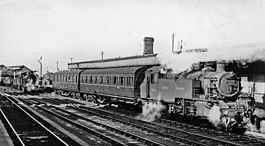Dudley railway station
| Dudley | |
|---|---|

An auto-train in 1961
|
|
| Location | |
| Place | Dudley |
| Area | Dudley |
| Coordinates | 52°30′53″N 2°04′29″W / 52.5146°N 2.0747°WCoordinates: 52°30′53″N 2°04′29″W / 52.5146°N 2.0747°W |
| Grid reference | SO950907 |
| Operations | |
| Original company | Oxford, Worcester and Wolverhampton Railway |
| Pre-grouping | Great Western Railway |
| Post-grouping | Great Western Railway |
| History | |
| 1860 | Opened |
| 6 July 1964 | Closed |
| Disused railway stations in the United Kingdom | |
| Closed railway stations in Britain A B C D–F G H–J K–L M–O P–R S T–V W–Z |
|
|
|
|
Dudley Railway Station was a passenger railway station located at Dudley, England, built where the Oxford-Worcester-Wolverhampton Line and the South Staffordshire Line diverged to Wolverhampton and Walsall and Lichfield respectively.
The station was built as a collaboration between the Oxford, Worcester and Wolverhampton Railway (which was soon to fall into the hands of the Great Western Railway, and the London and North Western Railway (which had taken control of the South Staffordshire Railway – the company that had constructed the line from Lichfield, via Walsall, to Dudley). The latter eventually became part of the London, Midland and Scottish Railway. The station was completed in 1860.
A racecourse had been situated just north of the station until the mid-1840s when it was closed to make way for the railway, but its name was revived during the 1980s when Racecourse Colliery, a model colliery, was opened on the site as part of the Black Country Living Museum.
The line had reasonable passenger usage until about the early 1880s, when it began to slump at several stations, leading to the line becoming a largely freight only operation in 1887. It would remain open for goods traffic, which was considerable at this time, as the district had become highly industrialised in the then heyday of the Black Country's industrial past.
As the local industry declined and road transport became more common, the station entered a post-World War 2 decline, although not as heavily as most others on the line.
...
Wikipedia
